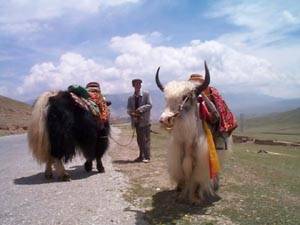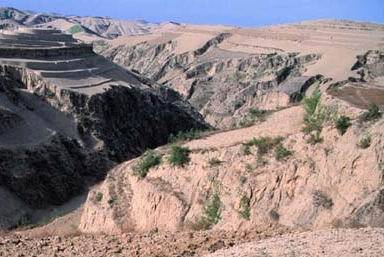Four Major Plateaus
The four major plateaus of China are the Qinghai-Tibet Plateau, the Inner Mongolia Plateau, the Loess Plateau and the Yunnan-Guizhou Plateau.
 Situated in southwest China, the Qinghai-Tibet Plateau is the largest plateau in China, covering 2.5 million square kilometers, or nearly a quarter of the national total land area. With an elevation averaging between 4,000 and 5,000 meters, it is the highest plateau on earth, and is known as the "roof of the world". The Himalayan Mountain is located in southern Qinghai-Tibet Plateau and its highest peak, Mount Qomolangma (or Mount Everest) is 8,848.13 meters above sea level. It is the highest peak in the world. Surrounded and traversed by several mountain ranges, the Qinghai-Tibet Plateau is where many of China′s major rivers originate. Boasting over 1,000 lakes, it is also a plateau with the most lakes worldwide, including the Qinghai Lake -- China′s largest saltwater lake.
Situated in southwest China, the Qinghai-Tibet Plateau is the largest plateau in China, covering 2.5 million square kilometers, or nearly a quarter of the national total land area. With an elevation averaging between 4,000 and 5,000 meters, it is the highest plateau on earth, and is known as the "roof of the world". The Himalayan Mountain is located in southern Qinghai-Tibet Plateau and its highest peak, Mount Qomolangma (or Mount Everest) is 8,848.13 meters above sea level. It is the highest peak in the world. Surrounded and traversed by several mountain ranges, the Qinghai-Tibet Plateau is where many of China′s major rivers originate. Boasting over 1,000 lakes, it is also a plateau with the most lakes worldwide, including the Qinghai Lake -- China′s largest saltwater lake.
The second largest plateau in China, the Inner Mongolia Plateau, lies between 1,000 and 2,000 meters above sea level in north China. It has a gentle rolling terrain and vast grasslands, with some parts covered with uninhabited Gobi and deserts.
 The Loess Plateau is surrounded by the Taihang Mountains on the west, the Qilian Mountains on the east, the Great Wall on the south and the Qinling Mountains on the north. It covers 580,000 square kilometers and lies 1,000 to 2,000 meters above sea level. Crisscrossed with ravines and gullies, it has fragmented landforms due to long-term scouring of rainfall and streams.
The Loess Plateau is surrounded by the Taihang Mountains on the west, the Qilian Mountains on the east, the Great Wall on the south and the Qinling Mountains on the north. It covers 580,000 square kilometers and lies 1,000 to 2,000 meters above sea level. Crisscrossed with ravines and gullies, it has fragmented landforms due to long-term scouring of rainfall and streams.
Covering east Yunnan Province and most parts of Guizhou Province, the Yunnan-Guizhou Plateau has an elevation of 1,000 to 2,000 meters. It has a terrain that descends from northwest to southeast and is covered with numerous mountain ridges, valleys and rugged landforms. The famous Huangguoshu Waterfall, largest in China, is on the plateau.
Source: http://www.chinaculture.org